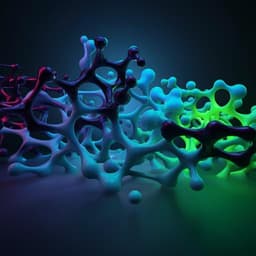
Engineering and Technology
How to speed up ion transport in nanopores
K. Breitsprecher, M. Janssen, et al.
This groundbreaking study conducted by Konrad Breitsprecher, Mathijs Janssen, Pattarachai Srimuk, B. Layla Mehdi, Volker Presser, Christian Holm, and Svyatoslav Kondrat reveals that slow voltage sweeps can significantly enhance the charging efficiency of ultranarrow pores, outperforming abrupt voltage steps and resolving ionic clogging issues. Their innovative approach shows promise for advancing energy storage technologies.
Playback language: English
Introduction
Electrolyte-immersed porous electrodes are fundamental to energy storage, harvesting, and capacitive deionization technologies. Electrical double layer capacitors (EDLCs), or supercapacitors, store energy via electrosorption of ionic charge into porous electrodes. Their performance is defined by energy density (ε) and power density (P). Nanometer-sized pores yield the highest capacitance and energy densities, making them a focus of research aiming to maximize energy density and charging/discharging speed. While charging and discharging times are often assumed equal and proportional to ε/P, this is inaccurate for potentials above the thermal voltage (~25 mV at room temperature). Molecular dynamics (MD) simulations show nanopores charge and discharge differently, necessitating separate optimization for each process. This study focuses on optimizing the time-dependent cell voltage to minimize charging and discharging times, a less-explored area in electrochemistry. The optimization of time-dependent protocols has been studied in other fields, such as quantum systems and Brownian particles. Finding optimal voltage sweeps for charging and discharging is crucial for improving supercapacitor performance and applications like electrochemical heat harvesting and capacitive deionization. Prior MD simulations revealed that abrupt potential application leads to counterion pore clogging and co-ion trapping, hindering charging dynamics. Linear sweeps, however, can avoid this. This study proposes a non-linear voltage sweep tailored to co-ion desorption rates, aiming to surpass the speed of even optimized linear sweeps. The effectiveness of both the non-linear and a voltage inversion discharging method are tested via MD simulations and experiments.
Literature Review
Extensive research has explored nanoporous supercapacitors, focusing on maximizing energy density and charge/discharge speed. Studies using molecular dynamics (MD) simulations have revealed the complex relationship between pore size, ion size, and capacitance, with anomalous increases observed at pore sizes below 1 nm. The importance of ion packing and the structure of the electrical double layer in influencing charging dynamics has also been highlighted. The charging mechanisms, particularly in ionic liquid electrolytes confined in subnanometer pores, have been investigated using various techniques like in situ NMR spectroscopy. Research has also focused on optimizing the design of porous electrodes to minimize internal resistances and accelerate charging/discharging processes. This includes exploring different pore shapes, lengths, and surface modifications to enhance ion transport and minimize clogging. Prior work by the authors showed the benefit of slow voltage sweeps for charging ultranarrow pores using a simple model, avoiding ionic clogging and co-ion trapping. This paper builds on those findings by experimentally verifying these simulations and proposing new, faster charging and discharging protocols.
Methodology
This study employed both MD simulations and experimental techniques to investigate charging and discharging optimization in nanopores.
**Simulations:** Molecular dynamics (MD) simulations were performed using the ESPResSo software package. The electrode geometry consisted of slit-shaped pores with defined dimensions (pore entrance and closing radii, width, and length). The Weeks-Chandler-Anderson (WCA) potential was used to model interactions between carbon atoms and ions. The ICC* algorithm simulated constant-potential conditions, accounting for charge induction and metallic boundary conditions. The velocity-Verlet algorithm was used in the NVT ensemble, with a Langevin thermostat to control temperature and mitigate the effects of Ohmic losses. The system was equilibrated before each simulation run. Different voltage sweep protocols (step, linear, and non-linear) were applied, and the resulting ion dynamics (counterion adsorption and co-ion desorption) were analyzed. The charging time was defined as the time when the accumulated charge reached 96% of the maximum capacity. The parameters of the stretched exponential and linear approximations in relation to the experimental values were determined using the dogleg least-square algorithm from scipy.
**Experiments:** Experiments were conducted using a symmetric two-electrode supercapacitor with novolac-derived activated carbon electrodes exhibiting a narrow pore-size distribution. The characterization of the material was done by gas sorption analysis and electron microscopy. EMIM-BF4 ionic liquid was used as the electrolyte. Charging experiments involved applying different voltage protocols (step, linear, and non-linear). The accumulated charge over time was measured. The experimental non-linear sweeps were generated computationally and implemented through piecewise linear approximations. Linear sweeps were achieved via one-cycle voltammetry. Discharging experiments used the same system, with comparisons made between step-voltage discharge and voltage inversion protocols. The discharging time was defined as the time at which the charge vanished and exhibited minimal fluctuations.
Data analysis involved fitting experimental data to appropriate models, such as the sum of two exponents for charge accumulation in step-voltage experiments. The optimal parameters for voltage sweeps (τ for charging and Uinv, kin for discharging) were determined by minimizing the respective charging and discharging times. The charging and discharging time were defined as the time needed to achieve 96% and 95% of the target charge, respectively.
Key Findings
This study presents several key findings regarding the optimization of charging and discharging in nanopores:
**Charging:**
1. **Experimental Verification of Slow Sweep Advantage:** Experiments confirmed that charging with a slow linear voltage sweep is significantly faster than with a step voltage, avoiding the pore clogging observed with the latter. This is the first experimental validation of previous simulation results.
2. **Non-linear Sweep Superiority:** MD simulations demonstrated that a non-linear voltage sweep, designed to match the co-ion desorption rate, leads to even faster charging compared to optimized linear sweeps, especially for longer pores. This non-linear sweep was derived from a theoretical model based on the co-ion density. Two closed-form approximations, a stretched exponential and a linear approximation, were also developed and tested. The stretched exponential approximation demonstrated significantly better agreement to the model data for longer pore lengths.
3. **Optimal Sweep Parameter:** The optimal charging parameter (τ) for the non-linear sweep was found to be at the intersection of counterion adsorption time and co-ion desorption time as a function of τ.
4. **Pore Length Dependence:** The difference in charging times between the optimal linear and non-linear sweeps increased with increasing pore length, suggesting that the non-linear approach becomes increasingly advantageous for longer pores.
**Discharging:**
1. **Voltage Inversion Enhancement:** MD simulations revealed that a voltage inversion discharging protocol significantly accelerates the discharging process compared to a simple step voltage. This approach involves applying a negative voltage briefly before sweeping back to zero. The optimal inversion voltage (Uinv) and sweep rate (kinv) were identified to minimize discharging time. The optimization revealed that there is a global minimum in discharging time.
2. **Experimental Validation of Voltage Inversion:** Experimental results using the same novolac-derived carbon electrodes confirmed that the voltage inversion method discharges the supercapacitor faster than the step voltage. Although some qualitative differences were observed between simulations and experiments, both confirmed the effectiveness of the voltage inversion method.
Discussion
This study demonstrates that carefully designed time-dependent voltage sweeps can significantly enhance the charging and discharging rates of nanopore-based supercapacitors without sacrificing energy storage capacity. The avoidance of pore clogging through slow voltage sweeps is crucial for improving overall efficiency, as seen both in simulation and experimentally. The superiority of the non-linear sweep over the linear sweep, especially for longer pores, underscores the importance of adapting the charging protocol to the specific dynamics of ion transport within the nanopores. The discovery of optimal parameters for both charging (τ) and discharging (Uinv, kinv) provides practical guidelines for designing more efficient charging/discharging circuits. The voltage inversion method offers a promising strategy for accelerated discharging, potentially enabling faster operation in applications like electrochemical heat harvesting and capacitive deionization. While some discrepancies between MD simulations and experimental results exist, the overall trends and the qualitative behavior are consistent. These discrepancies are largely attributed to the simplifications in the MD model which does not account for certain aspects of a real supercapacitor, such as ionic currents in the macropores. This study provides a comprehensive framework for optimizing ion transport in nanopores and has significant implications for improving the performance of various energy-related technologies.
Conclusion
This research provides a significant advance in understanding and controlling ion transport in nanopores. Through a combination of advanced MD simulations and experimental validation, it has been demonstrated that both carefully controlled charging and discharging voltage protocols can drastically speed up these processes in sub-nanometer pores. The non-linear voltage sweep offers a particularly promising approach for charging optimization, while voltage inversion significantly accelerates discharging. Future work could explore how these findings translate to different electrode materials, pore geometries, and ionic liquids. Furthermore, investigating the impact of ion asymmetry and the development of even more sophisticated time-dependent voltage profiles present additional research opportunities.
Limitations
The MD simulations, while detailed, employed simplifications such as the WCA potential and a simplified electrode model. These simplifications may not perfectly capture all the intricacies of real supercapacitors, and this could contribute to discrepancies between simulation and experimental results. The experimental validation focused on a specific type of activated carbon electrode and ionic liquid. The generalizability of these findings to other materials and electrolytes needs further investigation. The optimal parameters for the non-linear and voltage-inversion protocols might need to be adjusted based on specific supercapacitor designs and operating conditions. The experiments did not reach optimal sweep rates, leading to some ambiguity in the comparison of linear and nonlinear sweeps.
Related Publications
Explore these studies to deepen your understanding of the subject.







